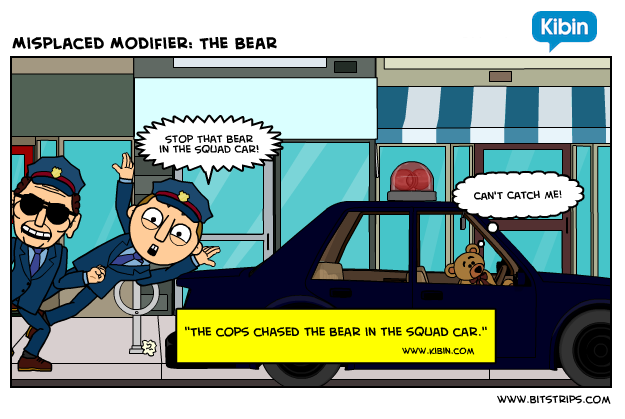Of all the possible grammar errors you can make, inserting a misplaced modifier into your sentence can lead to the most hilarious writing mistakes. In this post, I’m going to help you become a better writer by teaching you to recognize and correct problems caused by a misplaced modifier. You’ll learn how to avoid making this silly mistake in your next writing project.
What Is a Misplaced Modifier?
As I mentioned in my previous post, 7 Grammar Rules Everyone Should Learn, grammarians love to use complex words to describe simple grammar issues. However, a misplaced modifier isn’t as complex as its name would suggest.
Let me break this down for you. First let’s define a modifier. A modifier is a word or phrase that changes, or modifies, a part of a sentence. (Unfortunately, grammarians don’t have a word for the part of the sentence it changes. If you ask me, it should be called a “modifiee.” Since it’s not, we’ll just call it a “thing” or “part of a sentence.”)
It stands to reason that a misplaced modifier is a word or phrase that has been placed incorrectly in the sentence and, as a consequence, modifies the wrong thing.
Let’s play with an analogy here. Imagine a modifier being like a piece of clothing, a hat, for example. If you wear the hat on your foot, then you’ve simply misplaced the piece of clothing. It’s now keeping your foot warm instead of your head—and you look a little crazy. Simply move the hat from your foot to your head, and you’ve fixed the problem of your misplaced hat.
It works the same way as in a sentence where you’ve misplaced a word or a phrase. The misplaced modifier can change the intended meaning of the sentence—and make you sound a little crazy. Simply move the modifier to the right place in the sentence, and you’ve fixed the problem of your misplaced modifier.
A misplaced modifier can lead to ambiguity, misunderstanding, and sometimes even a slap in the face. No seriously, have you ever accidentally told your sister that she was roasted over an open flame?
Well no wonder she slapped you!
The easiest way to help you understand the problem with misplaced modifiers is to give you some examples of some of the funnier ones I’ve found while editing papers for Kibin.
To make these examples easier for you to follow, I’ll highlight the modifier in green.
Example of Misplaced Modifier Phrases
Sometimes a modifier is an entire clause or phrase in a sentence, not just a single word. When a misplaced modifier is a phrase, you’ll end up with a sentence like this:
“Covered in whipped cream, I was excited to eat the ice cream sundae.”
This sentence states that I am covered in whipped cream, not the sundae. We can save my skin from getting all sticky if we revise the sentence by moving our modifier to the correct place.
“I was excited to eat the ice cream sundae covered in whipped cream.”
As you can see from this example, the goal is to keep the modifier as close as possible to the thing that it’s modifying in the sentence. In this case, we want to keep the whipped cream close to the sundae and far away from me.
Here is another example of a misplaced modifier:
This sentence tells us that the bear is in the squad car, not the cops. To fix this mistake, let’s move our modifying phrase, “in the squad car,” closer to the cops.
That makes a lot more sense! Now we have the correct image in mind.
Here’s another example:
This sentence tells us that the kid has short legs. While this may be true, the writer surely meant he’s looking for a table with short legs. Let’s move the legs closer to the table in this revised sentence:
Now it’s clear that the table has the short legs.
In all of the above examples, I showed you what happens when you misplace modifying phrases. However, this problem can also occur with single words including adjectives and adverbs.
Example of a Misplaced Modifier Adjective
It’s a common mistake for adjectives to be misplaced in a sentence, as in the following:
In this sentence, the misplaced adjective silver modifies the word woman’s, so it seems as if the necklace belongs to a silver woman.
 Let’s revise by placing the modifying adjective (silver) closer to the noun that we’re modifying (necklace).
Let’s revise by placing the modifying adjective (silver) closer to the noun that we’re modifying (necklace).
Now it’s clear that the necklace is silver and has nothing to do with a silver woman.
Examples of Misplaced Modifier Adverbs
Similarly, it’s common to find misplaced adverbs in a sentence, as in the following:
“The man aimed the gun that he had hidden under the bed quickly.”
In this example, the misplaced adverb quickly accidentally modifies the verb hidden, making it sound like the man quickly hid the gun under the bed.
What the writer meant to say was that the man quickly aimed the gun, so we’d revise it like this:
“The man quickly aimed the gun that he had hidden under the bed.”
Now, the modifying adverb quickly correctly modifies the verb aimed.
Let me give you one more interesting example of a misplaced modifying adverb. Consider these three sentences, each with the word just in a different position:
- Jerry was just allowed to go back to work.
- Jerry was allowed to just go back to work.
- Just Jerry was allowed to go back to work.
The placement of the modifier just completely changes the meaning in each of the three sentences. Check it out:
- The first sentence means that Jerry was recently allowed to go back to work.
- The second sentence means that Jerry was only allowed to go back to work and nowhere else.
- The third sentence means that only Jerry and no one else was allowed to go back to work.
When you’re writing, it’s important to put the modifier in the correct position to convey your intended meaning. Pretty amazing that the placement of one little adverb can dramatically change the meaning of a sentence, isn’t it?
How to Avoid the Misplaced Modifier: A Review
- Remember, a misplaced modifier occurs when you put a modifying word or phrase in the wrong place in a sentence.
- To correct it, move the offending word or phrase to the right place in the sentence.
- Always make sure that the modifier and the thing it’s modifying are as close together as possible in the sentence.
- As a general rule, try not to let anything between the modifier and the thing it’s modifying.
Need more help? Read this article from Grammar Girl on misplaced modifiers. And don’t miss this post on dangling modifiers.
Watch out for this tricky grammatical error, or you might end up accidentally writing something you will regret. Sometimes the misplaced modifier is hard to catch. Kibin’s editors can help ensure you don’t make this mistake in your next writing project.
Have you ever made a silly writing mistake by misplacing a modifier? Let us know in the comments.
